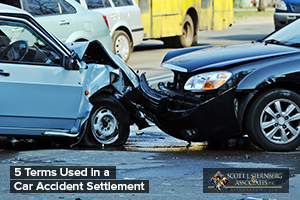According to the Insurance Institute for Highway Safety (IIHS), there were 32,166 motor vehicle crashes that resulted in fatalities in the United States in 2015 alone.
The result was 10.9 deaths per 100,000 people, and 1.13 deaths per 100 million miles traveled. Statistics reveal that more than 37,000 people die each year as a result of road crashes and another 2.35 million are either injured or disabled.
If you have been in a car accident and are planning to file a lawsuit or an insurance claim, you may find yourself submersed in the world of personal injury lawyers and insurance adjusters – all who speak in a language you do not fully understand.
As professionals in their respective fields, they have the training to know what certain terms and legal jargon mean, but things may not be as clear to you. This is why you should learn a few of the common terms that are used in car accident personal injury cases.
Here is a look at 5 terms you will often hear in a car accident settlement:
- Actual Cash Value: This is another way of saying the car’s “market value” when you file a property damage claim and your car needs to be repaired as a result of the accident. Actual cash value is measured by the amount the vehicle could have been sold for right before the accident damaged or destroyed it. In most cases, this term comes up when a vehicle is considered a “total loss”. In such a situation, the owner will be paid an equal amount to the actual cash value of the car by the insurance company, instead of being paid to get the car repaired.
- Total Loss: After an accident, when the repair cost would exceed the car’s value or when the car cannot be repaired, it is a total loss. As mentioned earlier, in such situations, the insurance company will offer the car’s actual cash value. A total loss can be determined for different types of car accidents.
- Negligence: When a person does not meet a duty of care that has been legally imposed, they are considered negligent. If damage is caused as a result of this negligence, then the negligent person could be held liable for that damage. A driver breaches this duty of care when they fail to operate a vehicle in a manner that is reasonable and safe.
- Negligence Per Se: This term is used to describe an act that is in and of itself careless, and once the commission of the act is established, it is not necessary to show any further evidence of fault. A driver involved in a car accident can be deemed “negligent per se” when they break a traffic law. For example, if you drive the wrong way down a one-way street or drive at twice the posted speed limit and then cause an accident, it obviously establishes negligence. Although the negligence per se of a driver does not translate into a win for the other party automatically, the negligent per se driver generally has a tough time digging out of this presumption.
- Uninsured/Underinsured Motorist Insurance (UIM): In most states, as part of an automobile insurance policy, drivers are required to carry uninsured/underinsured motorist insurance (UIM) coverage. This covers you when you have been hit by another driver who does not have insurance or does not have enough insurance to cover the damages resulting from the accident. In cases like this, any uncompensated damages should be compensated by your UIM coverage.
If you or a loved one has been injured in a car accident caused by another person’s negligence, you should seek the legal expertise of the car accident attorneys at Sternberg | Forsythe, P.A.
We make sure that your rights are protected and that you receive the maximum compensation you deserve for your injuries and other damages. Call us at (561) 687-5660 today and get a free consultation with one of our attorneys to determine if you have a personal injury case.

